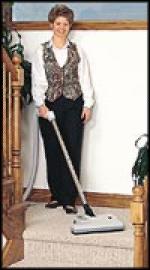Search engine visitors - click here to access entire "$ensible Home" web site
Click here to see a descriptive illustration of central vacuum cleaner power units and selected features.
Dear Jim: I have an efficient two-story house. I plan to install a central vacuum cleaning system myself to help control dust for my allergies. Will one work in a house such as mine and what features should I consider? - Pam B.

A: A central vacuum cleaning system is an excellent choice, particularly for an energy efficient, airtight house. I installed a central vacuum system in my own two-story house three years ago. It cleans very well and operates so quietly, I can talk on the phone while cleaning.
Some central vacuum cleaning systems exhaust the air outdoors, but most, such as mine, exhaust the clean air through a muffler into the utility room or basement. This eliminates concerns about having an airtight house.
Although central vacuum cleaning systems use a powerful motor, or several motors, in the central power unit, they are still plugged into a standard electrical outlet. Overall, they may end up using less electricity than a small portable vacuum because they thoroughly clean with less run time.
If you can saw a piece of two-inch-diameter plastic pipe, a few holes in drywall and run some safe low-voltage wire, you should be able to install a system yourself, even in a two-story house. To access the second floor, the pipe is often run up to the attic first and then down to one or two rooms.
When selecting a central vacuum system, the key items to consider are the cleaning power and the filtration method in the power unit. Don't be swayed by claims of "peak horsepower" of the motor indicating cleaning power.
The true cleaning power of any vacuum cleaner, central or portable, is the air flow rate (in cubic feet per minute - cfm) and the suction force (inches of water lift). Of these, the air flow is probably most important.
Through an engineering formula, air flow and suction are combined to yield an overall "air watts" power rating. This rating ranges from about 400 to 900 depending on the model. The size of your house, length of pipes, number of elbows, etc. all effect the amount of air watts your system requires.
Select a system that uses a filtration method with several stages. Models with a cyclonic filter spin the dirty air a at high velocity which causes the dirt to fall into a canister. The exhaust air then flows through a secondary filter. Other models use replaceable filter bags or combinations of the two.
A motorized brush powerhead is best for cleaning carpeting. Some models have a built-in microprocessor with indicator lights to set the height adjustment. Another convenient option is a sweep outlet for kitchens or other hard floors. The vacuum starts when you flip it open. Sweep the dirt to it and it is sucked away.
Instant Download Update Bulletin No. 831 - buyer's guide of 12 central vacuum systems manufacturers (55 models) listing type (cyclonic, self-cleaning, cloth or disposable bag), cleaning designs, air watts, dust capacity, cfm, suction in water lift, features, descriptions and illustrations of the various types of filtration methods, a layout guide, suggestions on planning your central cleaning system.
Dear Jim: I am going to have a burglar alarm system installed in my home and I am trying to decide between a wired and a wireless system. What type of alarm system do you think is best? - Peg B.
A: I just had a alarm system installed in my own home and I selected a Protection One wireless system. It is generally easier to install a wireless system in an existing home instead of trying to fish wires through the walls.
Another advantage of the wireless system is you can easily move the sensors as needed. For example, if you get a pet and it sets off a motion sensor, you may be able to reposition a sensor to avoid picking up the pet's movements.